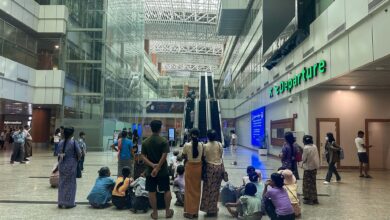
The Thein Sein government expected microfinancing, introduced to the country in 2011, to help reduce poverty in Myanmar. By offering collateral-free, low-interest loans to the poor, these communities would be able to build small businesses and create cottage industries, the thinking went.
Microlenders have since proliferated, but small businesses have not exactly boomed. In the current economic downturn, many borrowers have fallen into deep debt after turning to local, unauthorized lenders, for additional, high-interest loans to pay back their original loans with. A 2018 parliamentary report blamed a poor understanding of credit and finance for leading borrowers into what it called “debt traps.”
More than 3 million people have collectively received about 172 billion kyats in microloans from the 189 registered local and international lenders operating in Myanmar, according to the Ministry of Planning and Finance.
Myanmar Now spoke with economist Dr Zaw Oo, director of the Centre for Economic and Social Development and a former Presidential advisor, about microfinance and the country’s larger economic outlook.
Myanmar Now: Is microfinancing meeting its intended goals in Myanmar right now?
Dr Zaw Oo: Starting with the philosophy of microfinance – that every person should have reasonable access to low-interest loans – Myanmar’s microlenders have satisfied their main objective of inclusive finance. However, there is one problem: the larger economic picture makes it hard for poor people to invest that money in business growth or vocational training.
Even big enterprises in Myanmar are struggling at the moment, let alone small ones. Big entrepreneurs are waiting to see how things turn out, but for smaller ones, they can’t just sit and wait; they need to continue operating. They may add some capital into investments but mostly their businesses are still in the red and they’re falling further into debt.
The failure of microfinancing has more to do with the national economy. Myanmar is at the moment losing out on economic opportunities. A farmer might get a loan and invest in increasing production, but when they harvest their crops, the market is poor. Farmers have been hit hardest of all by Myanmar’s economic slowdown.
MN: Many borrowers have been taking out loans from more than one company and, when their businesses are unable to thrive, falling into debt. What is the root cause of this?
ZO: Many people in Myanmar struggle to make ends meet. They need investment money to keep their businesses [such as food shops, street hawking stalls, and farms] running. They do invest loans into their businesses but any profit goes straight to household expenses, so they have to find money elsewhere to pay back the loan. It’s a vicious cycle of debt. In order to break it, the national economy must improve.
We also need a credit bureau-like body to monitor the industry and collect information that can be used to reduce risk and craft better policy. More innovative monitoring techniques are needed. Loan approvals should depend on an individual’s ability to learn about markets and how to run a successful business. A small enterprise selling products online, for example, should be approved for a loan only after a careful check of their business records.
One might argue that not all data at the grassroots level can be collected by such a body, but there are other ways — indirect methods of data collection. That is where the national government can help. But we haven’t seen the government innovating here yet. It has declared a shift to an e-Government system but its not yet a people-centred e-Government system. Meanwhile, people at the grassroots are struggling with credit and debt. It’s not a good situation right now.
MN: Microfinancing was supposed to help alleviate poverty and reduce unauthorized money-lending. Has it done so at all, despite these setbacks?
ZO: The government’s main duty is to grow the economy. When the economy grows, tools like microfinancing can offer an equal opportunity for the poor to also enjoy this growth. This way, the poor won’t be left behind simply because they lack capital. If done right, even the poorest will be able to rise above the poverty level. Instead, economic stagnation is now keeping even the most powerful tycoons stuck, and the poor are the most unfortunate of all.
Economic development is crucial. It is the government’s primary responsibility, across all sectors. Then, the second step is enabling an inclusive microfinance sector to thrive in a growing economy. Without a grander economic strategy, a single tool [microfinance] won’t help to alleviate poverty.
The national economy has been declining for the past three years – a trend in which the poorest suffer the most. I think the government’s most important task is to find a solution that gets us past our economic woes.
MN: Anything else you’d like to add?
ZO: Interest rates have not been lowered [enough], and I think this is a problem. Those with the least money bear this burden most. When a country’s economy isn’t growing, borrowers still have to make payments, even if their revenue is shrinking. The interest rates are still [nearly] as high as ever. The government should consider lowering them again. Of course, they lowered annual interest rates from 30 percent to 28 percent in June 2019, but they’re still higher than they should be. There is also too much competition, with many microlenders vying for clients. More and more lenders have popped up despite a sluggish economy. It’s about time the government intervene and regulate the industry with an eye toward helping relieve debt for impoverished people that never learned about credit and finance. This is not about ‘financial inclusion’ anymore, it’s an issue of ‘overlending’ now.



